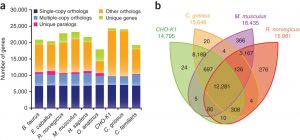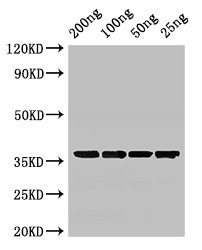Cusabio Cricetulus griseus Recombinant
Abstract
Chinese hamster Cricetulus griseus Recombinant ovary cells represent the dominant host for the production of therapeutic recombinant proteins. However, few large-scale data sets have been generated to characterize this host organism and derived CHO cell lines at the proteomic level. Accordingly, extensive label-free quantitative proteomic analysis of two cell lines (CHO-S and CHO DG44) and two Chinese hamster tissues (liver and ovary) was used to identify a total of 11,801 unique proteins that contained at least two unique peptides.

A total of 9,359 unique proteins were identified specifically in the cell lines, representing a 56% increase over previous work. Furthermore, 6663 unique proteins were identified in liver and ovary tissues, providing the first Chinese hamster tissue proteome. Protein expression was more conserved within cell lines during both growth phases than between cell lines, suggesting large genetic differences between cell lines. Overall, both gene ontology and KEGG pathway analysis revealed an enrichment of cell cycle activity in cells.
In contrast, upregulated molecular functions in tissues include glycosylation and lipid transporter activity. Furthermore, cellular components, including the Golgi apparatus, are upregulated in both tissues. In conclusion, this large-scale proteomic analysis allows us to delineate specific changes between tissues and cells derived from these tissues, which may help explain tissue-specific function and adaptations incurred by cells for applications in biopharmaceutical production.
KEYWORDS:
CHO, cell culture, hamster tissue, proteomics, mass spectrometry, pathway analysis, KEGG, gene ontology, ovary, liver.
Purity: >85% (SDS-PAGE)

Destination Names: BSG
Uniprot No.: Q99PA3
Alternative Names: BSGBasigin; CD antigen CD147; Fragment
Species: Cricetulus griseus (Chinese hamster) (Cricetulus barabensis griseus)
Form: Lyophilized powder
Buffer before lyophilization: Tris/PBS based buffer, 6% trehalose, pH 8.0
Reconstitution
We recommend that this vial be briefly centrifuged before opening to bring the contents to the bottom. Reconstitute protein in sterile deionized water at a concentration of 0.1-1.0 mg/mL. We recommend adding 5-50% glycerol (final concentration) and an aliquot for long-term storage at -20℃/-80℃. Our final default glycerol concentration is 50%. Customers could use it for reference.
Storage Conditions
Store at -20°C/-80°C upon receipt, need to be aliquoted for multiple uses. Avoid repeated cycles of freezing and thawing.
Shelf Life
Shelf life is related to many factors, including storage status, buffer ingredients, storage temperature, and the stability of the protein itself. Generally, the shelf life of the liquid form is 6 months at -20°C/-80°C. The shelf life of the lyophilized form is 12 months at -20°C/-80°C.
Delivery time
Delivery time may differ depending on the way or location of purchase, please consult your local distributors for the specific delivery time.
Notes: Repeated freezing and thawing is not recommended. Store working aliquots at 4°C for up to one week.


